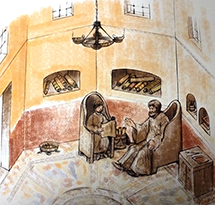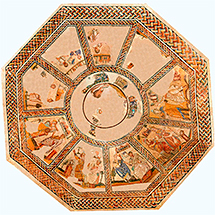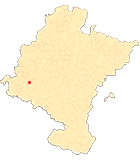The Roman villa of Arellano
Musaeum. Mosaic of the Muses
The beauty and technical perfection achieved by some compositions in Roman times earned them the name of mosaics. This name comes from the term opus musivum, a work inspired by the Muses. A magnificent pavement with figurative decoration is the emblematic mosaic of the Muses, currently in the National Archaeological Museum, which decorates a room with an octagonal floor plan, identified as the musaeumThe mosaic decorates an octagonal room identified as the Muses, a place for study and intellectual activities. It has a central circular emblem surrounded by nine radial compartments in which each of the nine Muses are depicted, accompanied by a "master", a name which refers to poets, philosophers or people devoted to intellectual activities. reference letter.
In each of the compartments there is a representation of a villa in the background, as well as various examples of different vegetation that serve as frameworkfor the different muses accompanied by the "master", such as Calliope, muse of oratory, possibly accompanied by Homer; Terpsichore with a lyre, muse of dance, accompanied by a young man; Melpomene, in a declamatory attitude, muse of tragedy; Thalia, muse of comedy accompanied by Menander, representative of the new comedy; Euterpe, muse of song and dance; Clio, muse of history, accompanied by the historian Cadmus; Urania, muse of astronomy, with one compartment remaining unidentified due to its poor state of preservation.
How to get there: The easiest way to get there is from the Pamplona - Logroño motorway, a few kilometres past Estella in the direction of Logroño, take exit 51 to Arróniz, on the NA-6340. After a few kilometres, the museum complex appears on the right.
Important: All information.
scheduleSee web page.
Bibliography: María Ángeles Mezquíriz Irujo, La villa romana de Arellano, Gobierno de Navarra, Pamplona, 2003.













